September 03, 2015
By Brad Miller, Ph.D.
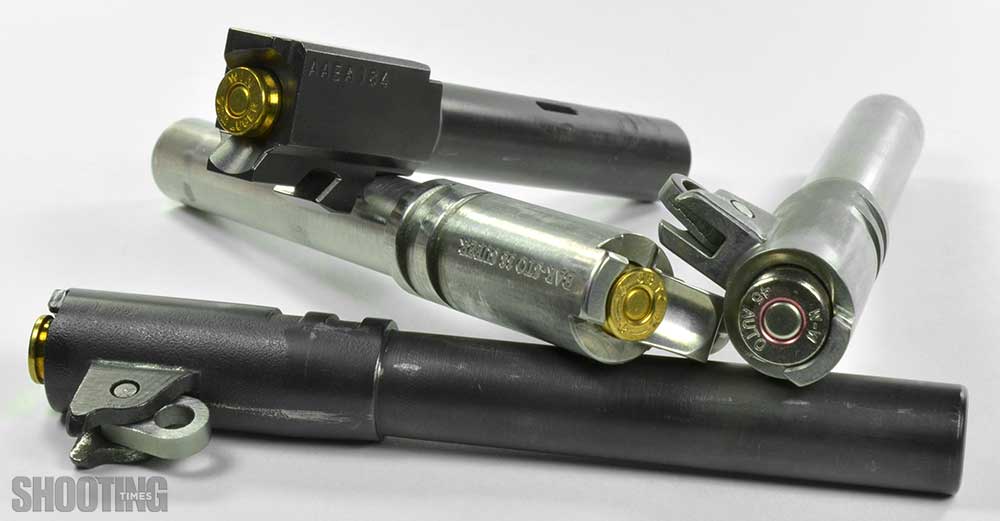
The plunk test. It's a funny name, but it's very important to use when you're reloading. The plunk test determines if your reloaded rounds will fit in your gun's chamber. The plunk test applies to handguns and rifles, but I'll focus on handgun ammunition.
The most common use of the plunk test is to determine if the bullet has been seated deep enough to fit in the chamber throat without touching the rifling. The throat is the cut ahead of the chamber that is the transition from the chamber to the riflings.
Plunk When Reloading?
Advertisement
If you're doing this test with a semi-automatic pistol, remove the barrel first (if mechanically possible). Make sure the chamber is clean because crud can build up and make perfectly good rounds fail the test.
The reloaded round should fall freely all the way into the chamber. If it does, it will make a "plunk" sound, hence the origin of the name. It should also fall freely out on its own when you invert the barrel. If it doesn't do this, there is a problem.
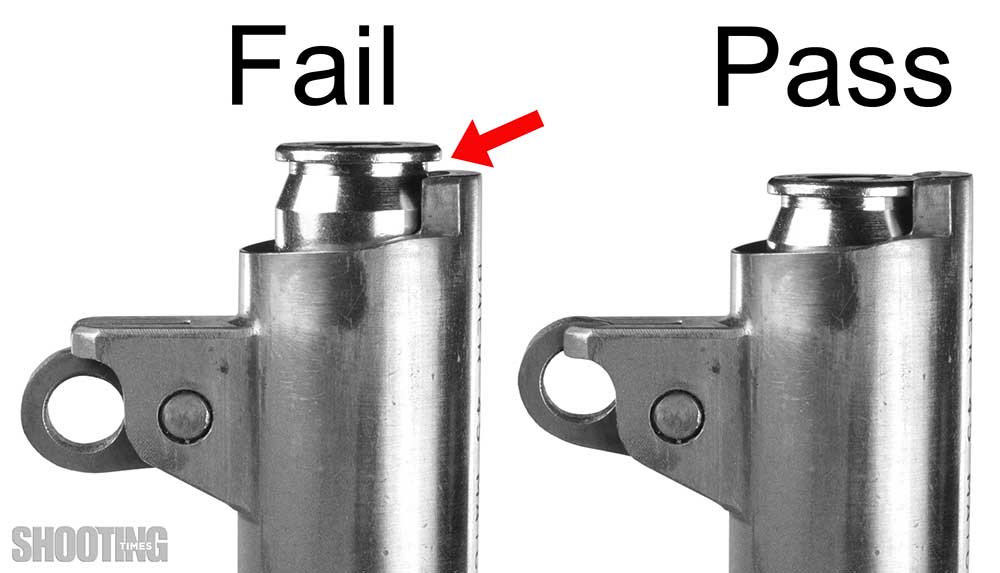 Does It Rotate?
Does It Rotate?
Advertisement
The test should really be called the Plunk and Rotate test. Some rounds will fall into the chamber and back out even though they make slight contact with the throat/riflings. That's why you should rotate the round when it is fully in the chamber. The round should rotate freely. This assesses whether the bullet touches the riflings, because you can feel if the bullet catches or drags during rotation. The advantage of the rotate test is that just plunking might miss a very small engagement of the bullet with the riflings. The rotate test will reveal this slight engagement.
While bullet seating depth is the most common application of the plunk test, the round can fail to fit for other reasons. 1) Improper crimp. 2) The brass is bulged from poor bullet alignment. 3) The brass is improperly sized.
Magic Marker Time
What do you do when the reloaded round fails the test? The way to determine where the round is sticking is to mark it with a magic marker and put it back in the chamber. Wiggle it around and rotate it so that the region that sticks will rub off the ink. Then inspect the round for missing ink.
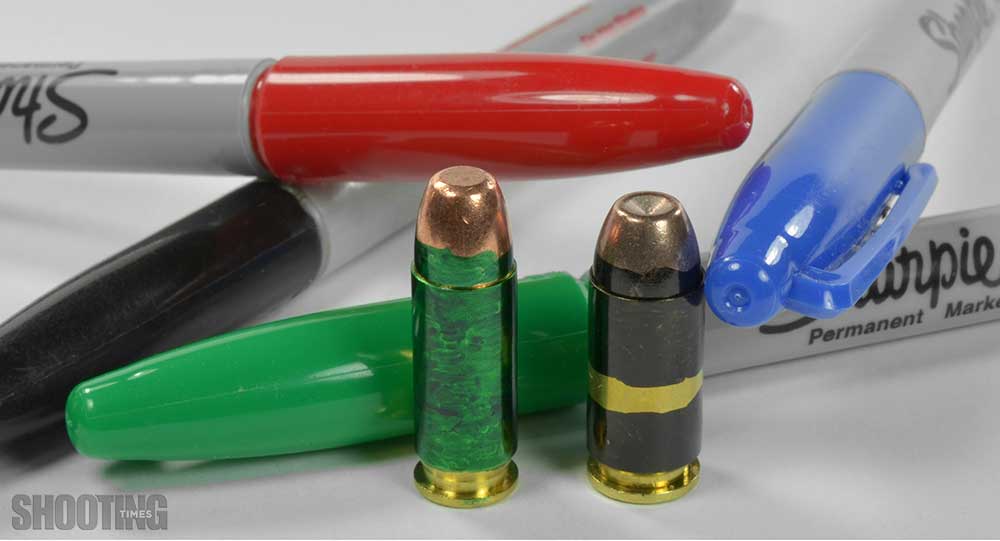 If the bullet is seated too long, there will be marks on the bullet. Seat the bullet deeper in small increments, say 0.005 inches, and try it again until it passes the test. For pistol ammo, a general rule of thumb is to seat the bullet at least 0.010 inches deeper than the minimum depth required to fit. This will allow a little tolerance to account for differences in bullet nose shape that varies from one bullet to the next, and for variations in actual seating depth from one round to another that can occur during the reloading process, an issue that is more common with some progressive reloading presses where the shell holder can tilt. It's okay to have more clearance, and depending on the bullet, you might have lots of clearance.
If the bullet is seated too long, there will be marks on the bullet. Seat the bullet deeper in small increments, say 0.005 inches, and try it again until it passes the test. For pistol ammo, a general rule of thumb is to seat the bullet at least 0.010 inches deeper than the minimum depth required to fit. This will allow a little tolerance to account for differences in bullet nose shape that varies from one bullet to the next, and for variations in actual seating depth from one round to another that can occur during the reloading process, an issue that is more common with some progressive reloading presses where the shell holder can tilt. It's okay to have more clearance, and depending on the bullet, you might have lots of clearance.
Since different brands of bullets have different shapes, you'll need to do the plunk and rotate test every time you reload a different bullet. For example, Hornady and Sierra bullet noses might have a different shape, one being longer than the other, so they might 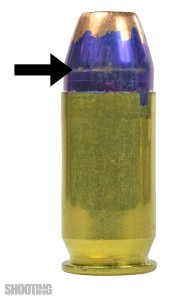 require a different overall length in order to fit in the chamber.
require a different overall length in order to fit in the chamber.
Be mindful of your overall length, because this will affect peak chamber pressure. You can use the overall length suggested in your reloading manual, and that usually works. Sometimes you might need to adjust the length to ensure reliable feeding or to fit in your pistol. It's okay if you're reloading longer; this will decrease pressure. If you're reloading shorter, this will increase pressure, and you might need to reduce the amount of gunpowder if your reload is already near the recommended maximum limit.
Crimp
The round might also fail if it has too little or too much crimp. We bell the case mouth of the brass to facilitate seating the bullet, but that bell must be removed by the crimp die or the round won't go into the chamber because the case mouth is wider than the inside of the chamber. Careful inspection or measuring the mouth will tell you if the bell has been removed.
Too much crimp can cause the brass to bulge, either right below the crimp or sometimes much lower if the case buckles. If the brass rubs just below the crimp, back off the crimp until the round fits the chamber.
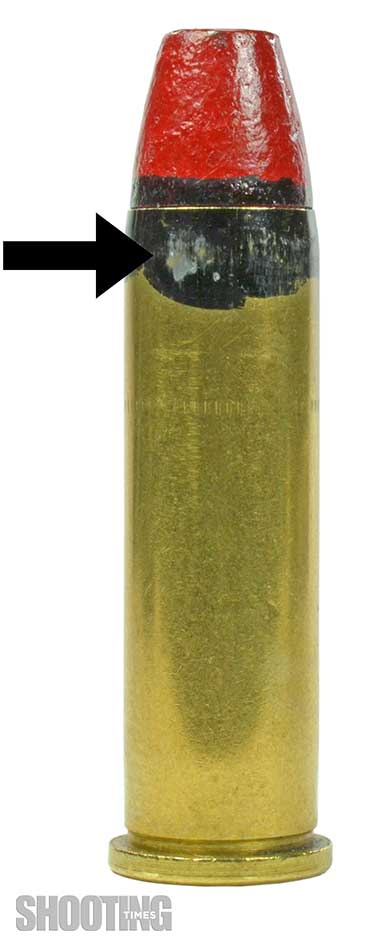 Not much crimp is required. Some folks suggest no crimp at all for their semi-automatic pistol ammunition, they just remove the bell. Other folks prefer to have a couple thousandths of an inch crimp. Ammunition for revolvers needs a roll crimp to prevent bullet pull where the bullet backs out of the case from the recoil.
Not much crimp is required. Some folks suggest no crimp at all for their semi-automatic pistol ammunition, they just remove the bell. Other folks prefer to have a couple thousandths of an inch crimp. Ammunition for revolvers needs a roll crimp to prevent bullet pull where the bullet backs out of the case from the recoil.
Bullet Alignment
Sometimes bullets get pushed into the case at a slight angle because the bullet nose was not centered and aligned by the seating die's stem. This produces a lopsided bulge at the bullet base that can prevent chambering. You might need to pull the bullet, and start over by resizing the case. Another way to correct this problem is to use a Lee Factory Crimp Die (handgun cartridges only) (leeprecision.com/reloading-dies/hand-gun-dies/lee-carbide-factory-crimp-die). This reloading die post-sizes the round back to proper dimensions and will iron out alignment bulges.
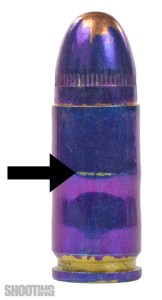 Case Head Bulge / Insufficient Sizing
Case Head Bulge / Insufficient Sizing
Some cases might be excessively bulged at the head just above the extractor groove. This might happen if your reload is hot and the brass has expanded into the unsupported region of your chamber, or you might see this in range brass that you have picked up where the original shooter's chamber dimensions are more generous than yours. Normally, your size die will correct this, but sometimes the bulge is low and the size die doesn't size that far down the case, or maybe your size die isn't screwed down as far as it should be. Whatever the reason, if this region is not sized enough, the round can fail the test.
Check your size die to make sure it is screwed down all the way according to the manufacturer's instructions. If that's okay, then maybe the brass needs to be sized farther down. Lee's undersize size die might or might not help depending on how far down the bulge is. Evolution Gun Works (www.egwguns.com) has a die that sizes farther down the case for 9mm Luger, .38 Special, .38 Super, .40 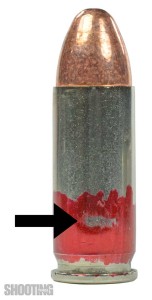 S&W and .45 ACP. In the extreme cases where these dies won't work, you might need a Lee Bulge Buster (http://leeprecision.com/case-conditioning-tools/lee-bulge-buster-kit/) or Redding G-RX die (http://www.redding-reloading.com/online-catalog/3-g-rx-push-thru-base-sizing-die). These are push-though dies, so they only work for rimless pistol cases. A roll die will also remove the bulge (for example, a Case-Pro: www.casepro100.com). Or just discard them. If the brass has a clear imprint of the feed ramp in it, I suggest that you throw them away as they might be weakened there and could rupture if you use them for reloading.
S&W and .45 ACP. In the extreme cases where these dies won't work, you might need a Lee Bulge Buster (http://leeprecision.com/case-conditioning-tools/lee-bulge-buster-kit/) or Redding G-RX die (http://www.redding-reloading.com/online-catalog/3-g-rx-push-thru-base-sizing-die). These are push-though dies, so they only work for rimless pistol cases. A roll die will also remove the bulge (for example, a Case-Pro: www.casepro100.com). Or just discard them. If the brass has a clear imprint of the feed ramp in it, I suggest that you throw them away as they might be weakened there and could rupture if you use them for reloading.
The last reason a round might not fit the chamber is because there is a significant ding in the rim. These dings have to be pretty severe to cause enough deformation of the rim to prevent it from fitting in the chamber, but it can happen. If you do the magic marker test but can't see that it's rubbing anywhere, maybe the rim is the problem. Try putting the round in backwards and see if the rim will enter far enough to determine if this is the cause.
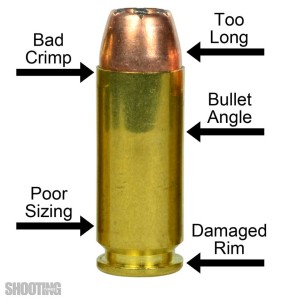 Chamber or Case Gauge?
Chamber or Case Gauge?
A case gauge can also be used for the plunk test. Keep in mind that a case gauge might not be the exact same dimensions as your pistol's chamber. Some folks have found that some rounds that won't fit in their case gauge will still fit in their barrel. Others have found just the opposite - the round fits the case gauge but not their barrel.
A case gauge can be very useful, but the best reloading device for the plunk test is your pistol's barrel because that's what you'll be shooting your ammunition from, not the case gauge.
Problem with the Chamber?
This discussion has focused on the ammunition as the source of the problem, but the problem might be the chamber. If the chamber is out of spec, it might not accept a round that is within SAAMI specifications. You might be able to make the round fit by making adjustments in the dies or some other accommodation, but you might be better off getting the chamber reamed to the proper dimensions. Official chamber dimensions can be found at the SAAMI website (www.saami.org), and you can compare measurements from the rounds you're reloading to the drawing dimensions to see if your chamber is the problem.

